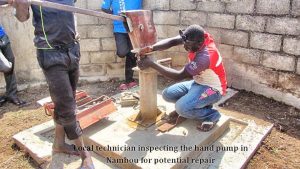This project is made possible through the partnership of Water Charity and the National Peace Corps Association. ![]()
This is a project under the LET GIRLS LEARN Program, a collaboration of First Lady Michelle Obama and the Peace Corps to expand access to education for girls around the world!
Location
Kante, Keran Prefecture, Kara Region, Togo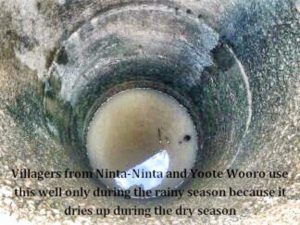
Community Description
Kante is a town located in the Kara region of Togo. It is the administrative capital of the Keran Prefecture. Though the official language of Togo is French, the dominant language spoken among the local inhabitants is Lama. Kante has a large population size of about 20,000, sparsely spread among its several neighborhoods, which can be considered independent villages. However, more than 85% of these inhabitants live in poverty or extreme poverty. A significant number of families live in small huts made entirely of mud, known as thatch roof houses, with an average of about 2-3 people per room, while the vast majority of people live in one, sometimes two-bedroom houses made of mud, coated with sand and cement.
The dominant activity in Kante is subsistence farming. The main crops include, but are not limited to corn, millet, yam, okra, and peppers. However, there is also livestock rearing, which includes cows, goats, sheep, guinea fowls, and pigs that are raised to generate income.
Problem Addressed
Life depends on water. A relatively healthy and prosperous life depends on a safe, portable, reliable and accessible water source. However, in Kante and surrounding villages, access to such a water source is extremely difficult during the rainy season, let alone the dry season.
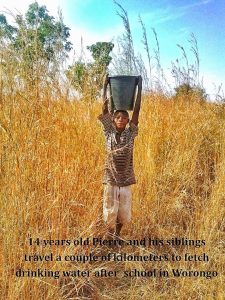 During the rainy season, most households get their drinking water from shallow potholes that are filled with run-off. This run-off is usually yellowish in color and filled with particulate matters. Oftentimes, these water sources are shared with animals. Drinking from this water source often leads to illnesses such as diarrhea, dysentery, and in some cases death particularly among children less than 7 years old.
During the rainy season, most households get their drinking water from shallow potholes that are filled with run-off. This run-off is usually yellowish in color and filled with particulate matters. Oftentimes, these water sources are shared with animals. Drinking from this water source often leads to illnesses such as diarrhea, dysentery, and in some cases death particularly among children less than 7 years old.
During the dry season, these shallow potholes dry out, leaving residents with the difficult task of traveling long distances to either buy water, or fetch it from a distant well. This is particularly daunting for young women and boys during the school year. This is because they not only have to get up early in the morning, sometimes at 3 AM, or late at night, to fetch water. Then they also have to come back, do house chores, and make breakfast or dinner before doing their homework or going to school. This provides a reasonable explanation of why most young women are more likely to fall behind in school or drop out compared to their male counterparts because of inadequate time to do school work. Even if they may have time to do school work, they may be too tired to concentrate. Also, lack of access to potable water nearby leaves young women vulnerable to attacks such as domestic violence at home due to husbands being suspicious of the amount of time taken to fetch water, and rape from outside while fetching water early in the morning or late at night.
Project Description
This project involves digging 8 public wells, installing 2 handwashing stations in two public schools, and repairing/rehabilitating of 3 community water pumps.
The site of each well was chosen by the various neighborhood/Village Development Committees with the help of a local hydraulic technician. Community members in these neighborhoods will help with the construction of these wells, and with the supervision of a local drilling technician. All eight wells will be similar in nature, including the depth of the water table.
Before calculating the cost of repairing and rehabilitating the pumps, a technician went and diagnosed all three pumps to find out what parts were needed to repair the pumps, and also the cost of each part. All three communities agreed to proportionally share the cost of repair, with each community agreeing to contribute at least 25% of the total cost.
The decision of the schools at which to install the handwashing stations was based on three main criteria: access to water to fill the water tanks, number of pupils in schools, and the percentage of students who stay in school during long breaks.
WELLS Seven of these public wells will be built in the same town, Kante, but in different neighborhoods: Yoote Wooro, Ate-Kante, Kpantchoute, Hourta, Worongo, Kouwir, and Ninta-Ninta. A local digging expert, with the help of local community members, will supervise the digging. This local expert has a wealth of experience digging holes in this region.
Before the digging process begins, a hydrogeological assessment will be conducted using hydraulic electrical measurement to determine the precise depth of the underlying aquifer. It is generally expected that water will be reached at a depth of 16 meters. However, the wells will be dug to a depth of about 21 meters to ensure a reliable source of water throughout the year. After the holes have been dug, the inner walls of the wells will be lined with concrete tubes, measuring about 1 meter in diameter. Above ground, the wells will be covered with a semi-concrete slab, a metal sheet, and enclosed with a brick fence measuring about three feet tall. The wells will all have covers to prevent dirt from entering.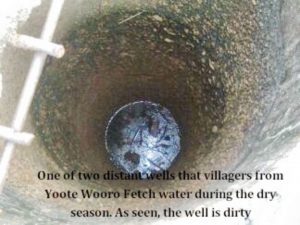
Also, a cement drainage system will be constructed to direct water into a nearby vegetable garden or a hole. A bucket and a rope will be used to pull water out of the well. Water Charity funds will be used to pay for skilled labor, to purchase of cement, and to transport materials.
The various communities will provide volunteer labor during digging and construction, gravel, sand, food for workers, and storage of materials. The remaining well will be built in a village called Kpesside, near the only clinic in the area. The reason for this location is to help patients with their hygiene and sanitation needs, especially pregnant women before, during, and after delivery.
PUMPS Three hand pumps will be rehabilitated in three villages (Houlure, Anatowa, and Nambou). A local technician has already estimated the costs of rehabilitating/repairing these pumps. The costs were determined by diagnosing each pump, and deciding what parts should be replaced or renovated. A couple of these hand pumps have been out of service for more than three years as a result of a lack of finance by the communities. As a result of this, community members have to walk for many kilometers to fetch water. Parts will be bought immediately for the repair work to begin. For the past six months, every household in the various villages has contributed some amount of money to meet the community contribution of 25% of the total repair cost. The various village development committees have been in charge of collecting the community contribution.
HAND WASHING STATIONS Two hand-wash stations will be built in schools in two villages called Houlio and Adeote. These hand wash stations will help students with their hygiene and sanitation needs. Students will use these stations to wash their hands before and after certain activities such as after using the toilet, and before and after eating.
Project Impact
This project will impact 5,348 people.
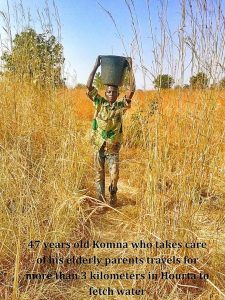 Peace Corps Volunteer Directing Project
Peace Corps Volunteer Directing Project
Mokube Ewane
Monitoring and Maintenance
Monitoring and maintenance of the wells and hand pumps will be done by each community’s Village Development Committee, or their Water Committees. The various Water/Village Development Committees have been trained on how to sustain their hand pumps and wells. For example, committee members and villagers have been educated on the importance of yearly monetary contributions for future repairs. The various schools’ Sanitary Committees, headed by the school principal, will maintain the handwashing stations.
Comments
The community organization involved in this project is Association Espoir Pour Demain (AED). They will be mobilizing the community.
Let Girls Learn
This project will significantly help girls stay in school, by reducing the time and distance they spend fetching water before and after school. For example, instead of walking for three kilometers to fetch water, most girls in the various communities that will benefit from this project will cut their travel distance to fetch water by more than 50-90%, hence giving them more time to study, and stay in school.
This is part of our ongoing Western Africa Water & Sanitation Program.
Dollar Amount of Project
$8,100
Donations Collected to Date
$0
Dollar Amount Needed
$8,100
ADOPT THIS PROJECT BY CONTRIBUTING THE DOLLAR AMOUNT OF THE PROJECT
Donations of any amount will be appreciated. The full amount will allow you a posted dedication, if that is something you would like.
This project has been completed. To read about the conclusion, CLICK HERE.
